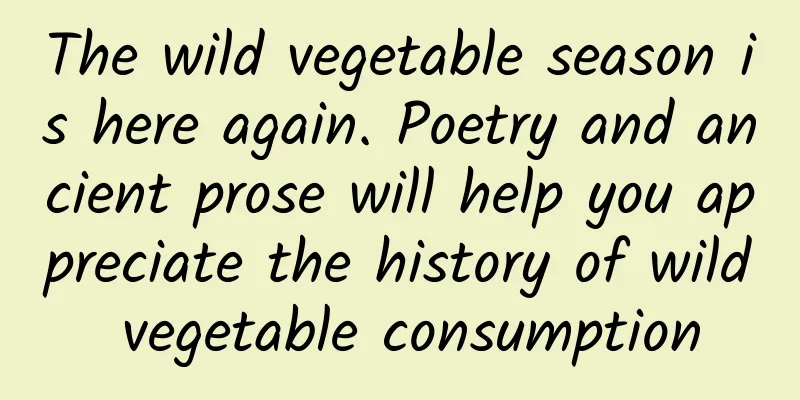The wild vegetable season is here again. Poetry and ancient prose will help you appreciate the history of wild vegetable consumption

|
Spring is the season for all things to grow, and the earth is covered with a new coat of green. Faced with the temptation of wild vegetables on the hillside, people go out of their homes to go outing and look for vegetables, as if they have become the hardworking and tenacious "Wang Baochuan". my country has a long history of eating wild vegetables, and many wild vegetables have been recorded in beautiful poems and ancient texts. Let's learn more about them! From the Book of Songs to the present day, wild vegetables are always present When I was a child, there were few cars and few buildings on the streets and alleys, but many people and trees. If you go a little away from the center of the city to the suburbs, you can see many species of animals and plants that are rare in cities now. Toona sinensis, Ailanthus toon, acacia, prickly ash, dandelion, shepherd's purse, wormwood, water celery... There are many common edible wild plants that can be named. These plants are not only part of the beauty of nature, but can also be used as food, becoming wild game delicacies on people's tables, and they were also the saviors of people's hunger during famines. In ancient my country, there were some books on famine relief that studied edible wild plants. Among them, the more famous ones include "Herbal Medicine for Famine Relief" and "Wild Vegetables Cookbook". my country has a long history of eating wild vegetables, and many wild vegetables have left their names in beautiful poems and ancient prose. The Book of Songs says: "I climbed the southern mountain to pick ferns. Before I saw the gentleman, I was worried. When I saw him, I was relieved." It tells the story of a woman who missed her beloved while climbing the mountain to pick ferns in spring. She hoped to see him, and if they did, she would snuggle up to him and feel happy. Bracken is a popular wild vegetable both in ancient and modern times. It belongs to the family Pteridaceae and is distributed in the mountains and forests in most parts of my country. We eat the tender leaves of bracken on a daily basis. In addition to being consumed by the Chinese people, bracken produced in China is also exported in large quantities to Asian countries such as South Korea and Japan. In traditional Chinese medicine, according to the Compendium of Materia Medica, the whole plant of bracken can be used as medicine, with the effects of clearing heat and lubricating the intestines, lowering qi and resolving phlegm, diuresis and calming the nerves, and lowering blood pressure. Modern research shows that wild bracken is very rich in nutrients, with high content of protein, minerals, lysine, γ-aminobutyric acid, etc. Among them, γ-aminobutyric acid is an important inhibitory neurotransmitter with important physiological functions, such as anti-epileptic, sleep promotion, and blood pressure reduction. However, on the other hand, bracken contains a carcinogen called protopteroside. Studies in Japan and other countries have found that this substance is indeed carcinogenic. Residents in some areas of Japan who often eat bracken have a higher incidence of esophageal cancer. Some people may ask, can bracken still be eaten? In fact, as long as bracken is not eaten in large quantities for a long time like daily vegetables such as cabbage and greens, there is no need to worry about its carcinogenicity; if it is soaked, blanched, steamed, boiled, fried or stir-fried before eating, the protopteroside content has been greatly reduced, so there is no need to worry. "Lüshi Chunqiu" says: "Among the most beautiful vegetables, there is the celery from Yunmeng." Yunmeng refers to the area of Yunmeng County in Hubei Province today. It belonged to the Chu State during the Warring States Period. The celery from Yunmeng was a famous agricultural product at that time. Celery in ancient China mostly refers to water celery, also known as water celery. It is different from the celery/parsley that we often eat at home today. It is said that it tastes a bit like water spinach. Water celery should be a wild vegetable that the ancient Chinese often ate. It is also recorded in the "Book of Songs", such as "Thinking of the joy of pan water, picking its celery thinly". The saying "offering celery" is also retained in modern Chinese, which is used to modestly express that the gift given to others is meager or the suggestion made is shallow. Watercress flowers The edible effects of celery are well known to modern people - it is almost common knowledge that celery can lower blood pressure. This effect comes from the apigenin it contains, a flavonoid compound that has antioxidant, anti-tumor, anti-inflammatory, blood pressure lowering, blood lipid lowering, anti-anxiety and immunity enhancement effects. Water celery is a type of celery, which is also rich in apigenin, so eating wild water celery can also lower blood pressure and other effects. Gramineae, also known as seaweed and hair vegetable, is a large seaweed. It is named because its tender stems resemble dragon's beard. It is widely distributed in my country and is also a famous wild vegetable. "Compendium of Materia Medica" records: "Dragon's beard grass grows on rocks on the southeast coast. It grows in clumps without branches, and its leaves are shaped like willow roots, more than a foot long, and white in color. It is eaten soaked in vinegar, and is also good when steamed with meat." Liang Shiqiu said in "Talks on Food in Yashe" that dragon's beard grass with abalone slices is a very outstanding cold dish; there is also Shanghai's shredded ham fried with fresh dragon's beard grass, which has great color and taste; Beijing has the famous dish "Dragon's beard grass stewed in fermented duck mud"; foreigners also eat dragon's beard grass, and it can also be found in Western cuisine. In addition to its delicious taste, Agaricus lemaneiformis is also rich in active polysaccharides, phycoerythrin and dietary fiber, and has multiple functions such as regulating immune activity, anti-tumor, anti-oxidation and anti-virus. Regular consumption can prevent hyperlipidemia, hypertension and cancer, and has attracted much attention from nutritionists. In addition to its therapeutic effects, Agaricus lemaneiformis can also play an active role in the management of modern water environment. Studies on the bioremediation of eutrophication caused by animal aquaculture have shown that large-scale planting of Agaricus lemaneiformis can reduce the pollution of seawater in aquaculture areas and prevent eutrophication of water bodies. Water shield is a wild vegetable with Jiangnan characteristics. It has a soft and smooth taste and a long history of consumption. It has been recorded in the Book of Songs and has appeared in many documents of later generations. It has even formed a water shield culture. Literati use water shield to express homesickness and farewell. Du Fu has a poem: "I miss the taro in Minxia, and you miss the water shield thousands of miles away. Separation in life and death has always been bitter." Bai Juyi has a poem saying "I still have the desire to eat perch and water shield. I may go to Jiangdong next spring." Su Shi once said, "If you ask about the wonderful things in the Three Wus, it is not only the water shield soup thousands of miles away." In terms of eating methods, Chinese people like to use water shield to make water shield soup. "Shishuo Xinyu" records that "there is a thousand-mile water shield soup, but it has not been salted and fermented with black beans"; "Shishuo Xinyu" is a book from the Southern and Northern Dynasties, which shows that from the Spring and Autumn Period to the Southern and Northern Dynasties, water shield has been a frequent guest on the Chinese table. In the Tang and Song Dynasties, making water shield soup with water shield and fermented black beans was still a popular way of eating, and there are ancient texts to verify it. There is also a method called "Four Beauties Soup", which is a soup made of four ingredients: water shield, mushrooms, crab roe and fish ribs, and is said to be extremely delicious. In modern times, in addition to traditional ways of eating, people have also developed new water shield foods such as water shield carrot juice and other water shield beverages, water shield bread, and water shield biscuits. The famous West Lake water shield soup Unfortunately, due to the strict requirements of the growth environment of water shield, it can only grow in lakes, ponds and swamps with very clean water quality. Due to factors such as water pollution and water environment damage, wild water shield is now endangered and is listed as a national first-class key protected wild plant. If you want to eat water shield, you can only buy artificially cultivated water shield. Water shield is rich in nutrients, rich in polysaccharides, proteins, amino acids, multiple vitamins and trace elements. The polysaccharides are a good immunostimulant that can inhibit the generation and development of tumors and have anti-cancer effects. In traditional Chinese medicine, water shield also has the effects of clearing heat, reducing swelling, detoxifying, appetizing, replenishing qi, and lowering blood sugar. In addition, there is a layer of slippery jelly on the surface of water shield stems and leaves, which is water shield pectin, which can moisturize the skin and moisturize. If used for face application, the effect may be comparable to that of ordinary facial masks. Toona sinensis The above mentioned types are wild vegetables that grow on the ground and in the water. There are also some wild vegetables that grow on trees, that is, edible buds, leaves or flowers of trees, etc. Chinese toon is one of them. Anyone who has eaten Chinese toon will smell its fresh and special fragrance when they see the word "Chinese toon". This special fragrance comes from special volatiles in Chinese toon buds, such as caryophyllene, which is a commonly used food spice with a mixed aroma of citrus, camphor and cloves. Modern research shows that Chinese toon has high nutritional value. Every 100g of fresh buds and leaves contains about 9.8g of protein, 56mg of vitamin C, 3.4mg of iron, 548mg of potassium, 110mg of calcium and 17 kinds of amino acids. Among them, the content of protein and vitamin C ranks first among all vegetables, and there are many kinds of essential amino acids for the human body and high content. It is said that the first person who proposed that Chinese toon can be eaten was Meng Shen from the Tang Dynasty, who was also the founder of dietotherapy and wrote the world's earliest existing dietotherapy monograph "Dietotherapy Materia Medica". After the Tang Dynasty, people in the Song, Yuan, Ming and Qing dynasties and modern times loved to eat Chinese toon, and the ways of eating were similar, such as Chinese toon eggs, Chinese toon tofu, pickled Chinese toon, etc. "Collect the first buds of Chinese toon, blanch them in soup, add a little salt, dry them in the sun, and they can be kept for more than a year. The new ones can be added to tea, and are most suitable for stir-frying gluten, stir-fried tofu, and other ingredients." This is a record in the Ming Dynasty's "Zunsheng Bajian". In addition to its edible value, Chinese toon also has high medicinal value. According to modern pharmacological research, Chinese toon leaves contain polyphenol compounds, most of which are natural antioxidants and have antibacterial and antiviral effects; some Chinese toon leaf extracts can inhibit the proliferation of ovarian cancer cells, induce apoptosis of certain white blood cells, or have cytotoxicity to prostate cancer cells. In short, Chinese toon leaf extracts have certain anti-cancer properties; in addition, Chinese toon leaf extracts also have the effect of lowering blood sugar. In addition to Chinese toon, there is another popular wild vegetable on the tree - Robinia pseudoacacia. Robinia pseudoacacia, also known as Robinia pseudoacacia, is a deciduous tree widely planted in northern my country. It blooms in April and May every year, and the fragrance of flowers is overflowing. This is also the best time to eat Robinia pseudoacacia flowers. The most classic way to eat Robinia pseudoacacia flowers is to steam them. Pick fresh Robinia pseudoacacia flowers in bud, wash and drain, add a little salt, then add an appropriate amount of flour and mix well, put them in a steamer and steam them, steam them and serve them on a plate, drizzle with garlic, soy sauce, chili and other dipping sauces, and a fragrant steamed Robinia pseudoacacia flower is ready. Steamed Robinia pseudoacacia flowers well preserve the original flavor and nutrition of Robinia pseudoacacia flowers, and they are delicious in color, aroma and taste. It is also a delicacy that the editor has been dreaming of since childhood. In addition, there are also ways to eat Robinia pseudoacacia buns, Robinia pseudoacacia meatballs, Robinia pseudoacacia soup, and Robinia pseudoacacia scrambled eggs. From a nutritional point of view, Sophora japonica contains a lot of pollen, which is very rich in nutrients, including protein, amino acids, multiple vitamins and minerals. Some studies have shown that its nutritional value is higher than that of beef, eggs, milk, wheat and other foods. In addition to the above, there are many other common wild vegetables, such as shepherd's purse, purslane, bitter herb, platycodon, dandelion, wild amaranth, etc. Some research literature points out that there are 1,822 species of wild vegetables from 213 families in my country, and 100 to 200 species are commonly eaten. It can be seen that "eating in China" is indeed worthy of its name. Don't pick wild vegetables on the roadside Seeing that wild vegetables are so delicious and nutritious, do you have the urge to pick and eat them? Here, the editor would like to remind everyone that when eating wild vegetables, try to choose traditional, locally grown wild vegetables that have a history of consumption for many years (such as those described above). Do not eat wild vegetables that you are not familiar with or whose origins are unknown. Be cautious when eating some newly appeared or introduced wild vegetables. First, newly emerged wild vegetables may be toxic if they have not been verified for long-term safety or have not been tested for safety by relevant institutions. A famous case is the KFC "Tianluxiang" incident in 2005. At that time, KFC launched a new drink "Furong Tianluxiang Soup", which contained the wild vegetable Tianluxiang. After the media questioned whether Tianluxiang was toxic, the Guangdong Provincial Food Safety Expert Committee held an emergency meeting to evaluate the edible safety of Tianluxiang. The evaluation result showed that "Tianluxiang" was indeed toxic, and three suggestions were made: "Tianluxiang" should not be promoted as a vegetable for planting; residents should not eat it for a long time; based on the existing data, occasional consumption has not been found to be toxic to the human body. The final result of the incident was that KFC stopped selling "Furong Tianluxiang Soup". Second, wild vegetables that are not sold in formal markets or that we pick randomly on the roadside, in parks and other urban green spaces are not suitable for consumption. Many elderly people like to dig wild vegetables in parks or highway green belts when they are walking in the park, doing morning exercises or taking a walk, thinking that these natural wild vegetables are healthy and delicious. In fact, this is very undesirable. Think about it, the wild vegetables on the roadside are "bathed" in car exhaust every day, and the content of heavy metals such as lead and mercury and other harmful substances may exceed the standard; the lawns in the park may be sprayed with herbicides, insecticides and other pesticides, and related toxic substances may remain on the wild vegetables therein, and the feces of pet cats and dogs in the park will also cause pollution to them; there are also some residential green spaces built on construction waste, community green spaces on the original industrial sites, and riverside ditches where industrial wastewater flows, etc. The wild vegetables grown on them may be contaminated by a variety of pollutants, and these wild vegetables are not suitable for consumption. Therefore, "natural" does not mean "green and pollution-free", and "picked by yourself" does not mean "safe and healthy". If you want to enjoy delicious wild vegetables in a healthy way, for urban people who basically have no chance to dig and pick wild vegetables in the mountains and forests far away from pollution, it is wise to buy wild vegetables with the "green food" certification mark in regular markets. Such wild vegetables are safe and guaranteed. |
<<: This food is not only a must-have for cooking, it can also treat rare diseases!
Recommend
Basic data that operators must know: Data analysis on "new users"
As an operator , it is essential to deal with dat...
I rubbed my eyes and saw strange patterns. Did I peek into the secrets of heaven?
After using our eyes for a long time, our eyes wi...
91 Ten Articles: NIO’s first overseas stop is Norway, Wuling Hongguang is exported to Lithuania at a high price of 20,000 euros
1. Li Bin, founder, chairman and CEO of NIO, once...
Traveling through time and space to fall in love with Hua Wuque: How to use webshell to promote and optimize black industry websites
When you put aside your dignity to make money, it...
“I discovered it!” Darwin and Einstein also “competing for the first place”?
Text| Shi Xiaolei The third issue of Physics maga...
A woman got nasopharyngeal cancer just because she ate this dish frequently! Many people eat this dish every day...
Expert of this article: Hu Zhongdong, Chief Physi...
Traffic, winners, paid future... this year of content entrepreneurship!
The top picture of this article is Luo Zhenyu, th...
2020 Private Domain Traffic Full Link Practical Operation Guide
Private domain traffic is a mechanism to better s...
An introduction to the promotional material specifications for Penguin FM’s splash screen ads!
1. Penguin FM splash screen ads Displayed to user...
Is iOS jailbreaking still your thing? Talking about iOS jailbreaking and its future
A while ago, iOS 11.2.1-11.3.1 jailbreak was offi...
Google Pixel 5 major regrets
On October 4, Google officially brought us the ne...
Major breakthrough in non-volatile memory: expected to completely replace existing hard drives
Russia's Sputnik News reported on January 16 ...
Moutai has officially announced another product, this time it’s Dove! Do you want to buy two chocolates with liquor filling for 35 yuan?
Recently, two well-known brands "combined&qu...
Can't tell the difference between spring, summer, autumn and winter? Cold wave, sandstorm and gale warnings issued in succession, with local temperature dropping by more than 20℃
From today (25th) to the 30th, a cold wave will a...
How did Keep use the "mine-laying plan" to cold start after accumulating 6 million users in 6 months?
Many products are in the early stages of promotio...









